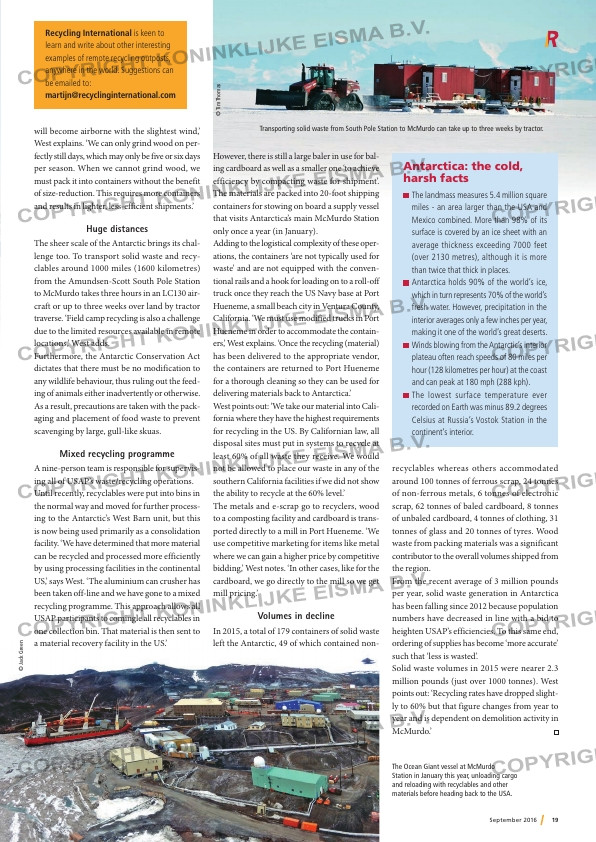Page 19 from: September 2016

19September 2016
will become airborne with the slightest wind,’
West explains. ‘We can only grind wood on per-
fectly still days, which may only be five or six days
per season. When we cannot grind wood, we
must pack it into containers without the benefit
of size-reduction. This requires more containers
and results in lighter, less-efficient shipments.’
Huge distances
The sheer scale of the Antarctic brings its chal-
lenge too. To transport solid waste and recy-
clables around 1000 miles (1600 kilometres)
from the Amundsen-Scott South Pole Station
to McMurdo takes three hours in an LC130 air-
craft or up to three weeks over land by tractor
traverse. ‘Field camp recycling is also a challenge
due to the limited resources available in remote
locations,’ West adds.
Furthermore, the Antarctic Conservation Act
dictates that there must be no modification to
any wildlife behaviour, thus ruling out the feed-
ing of animals either inadvertently or otherwise.
As a result, precautions are taken with the pack-
aging and placement of food waste to prevent
scavenging by large, gull-like skuas.
Mixed recycling programme
A nine-person team is responsible for supervis-
ing all of USAP’s waste/recycling operations.
Until recently, recyclables were put into bins in
the normal way and moved for further process-
ing to the Antarctic’s West Barn unit, but this
is now being used primarily as a consolidation
facility. ‘We have determined that more material
can be recycled and processed more efficiently
by using processing facilities in the continental
US,’ says West. ‘The aluminium can crusher has
been taken off-line and we have gone to a mixed
recycling programme. This approach allows all
USAP participants to comingle all recyclables in
one collection bin. That material is then sent to
a material recovery facility in the US.’
However, there is still a large baler in use for bal-
ing cardboard as well as a smaller one ‘to achieve
efficiency by compacting waste for shipment’.
The materials are packed into 20-foot shipping
containers for stowing on board a supply vessel
that visits Antarctica’s main McMurdo Station
only once a year (in January).
Adding to the logistical complexity of these oper-
ations, the containers ‘are not typically used for
waste’ and are not equipped with the conven-
tional rails and a hook for loading on to a roll-off
truck once they reach the US Navy base at Port
Hueneme, a small beach city in Ventura County,
California. ‘We must use modified trucks in Port
Hueneme in order to accommodate the contain-
ers,’ West explains. ‘Once the recycling (material)
has been delivered to the appropriate vendor,
the containers are returned to Port Hueneme
for a thorough cleaning so they can be used for
delivering materials back to Antarctica.’
West points out: ‘We take our material into Cali-
fornia where they have the highest requirements
for recycling in the US. By Californian law, all
disposal sites must put in systems to recycle at
least 60% of all waste they receive. We would
not be allowed to place our waste in any of the
southern California facilities if we did not show
the ability to recycle at the 60% level.’
The metals and e-scrap go to recyclers, wood
to a composting facility and cardboard is trans-
ported directly to a mill in Port Hueneme. ‘We
use competitive marketing for items like metal
where we can gain a higher price by competitive
bidding,’ West notes. ‘In other cases, like for the
cardboard, we go directly to the mill so we get
mill pricing.’
Volumes in decline
In 2015, a total of 179 containers of solid waste
left the Antarctic, 49 of which contained non-
recyclables whereas others accommodated
around 100 tonnes of ferrous scrap, 24 tonnes
of non-ferrous metals, 6 tonnes of electronic
scrap, 62 tonnes of baled cardboard, 8 tonnes
of unbaled cardboard, 4 tonnes of clothing, 31
tonnes of glass and 20 tonnes of tyres. Wood
waste from packing materials was a significant
contributor to the overall volumes shipped from
the region.
From the recent average of 3 million pounds
per year, solid waste generation in Antarctica
has been falling since 2012 because population
numbers have decreased in line with a bid to
heighten USAP’s efficiencies. To this same end,
ordering of supplies has become ‘more accurate’
such that ‘less is wasted’.
Solid waste volumes in 2015 were nearer 2.3
million pounds (just over 1000 tonnes). West
points out: ‘Recycling rates have dropped slight-
ly to 60% but that figure changes from year to
year and is dependent on demolition activity in
McMurdo.’
©
J
ac
k
G
re
en
Antarctica: the cold,
harsh facts
The landmass measures 5.4 million square
miles – an area larger than the USA and
Mexico combined. More than 98% of its
surface is covered by an ice sheet with an
average thickness exceeding 7000 feet
(over 2130 metres), although it is more
than twice that thick in places.
Antarctica holds 90% of the world’s ice,
which in turn represents 70% of the world’s
fresh water. However, precipitation in the
interior averages only a few inches per year,
making it one of the world’s great deserts.
Winds blowing from the Antarctic’s interior
plateau often reach speeds of 80 miles per
hour (128 kilometres per hour) at the coast
and can peak at 180 mph (288 kph).
The lowest surface temperature ever
recorded on Earth was minus 89.2 degrees
Celsius at Russia’s Vostok Station in the
continent’s interior.
The Ocean Giant vessel at McMurdo
Station in January this year, unloading cargo
and reloading with recyclables and other
materials before heading back to the USA.
Transporting solid waste from South Pole Station to McMurdo can take up to three weeks by tractor.
©
T
im
T
ho
m
as
Recycling International is keen to
learn and write about other interesting
examples of remote recycling outposts,
anywhere in the world. Suggestions can
be emailed to:
[email protected]



